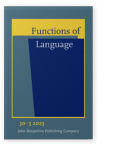Vol. 30:3 (2023) ► pp.320–348
Cardinal direction judgment based on the integration of spatial reference frames in different languages
This study investigates how integrated egocentric and environmental reference frames influence direction determination and cardinal direction judgments in L1 speakers of Mongolian and Mandarin. The results show that in direction determination, Mandarin participants’ integrated frame of reference is “front-north, back-south, left-west, and right-east.” By contrast, Mongolian participants use two modes of integrated spatial representation: “front-south, back-north, left-east, and right-west” and “front-north, back-south, left-west, and right-east”. This behavior points to influences from the participants’ dominant and non-dominant languages. Mongolian and Mandarin participants showed a north advantage in cardinal direction judgment tasks with a “front-north” response configuration. Whereas Mandarin participants consistently showed a north advantage effect, Mongolian participants showed a south advantage effect in the “front-south” configuration. This suggests that in addition to the long-recognized difference in north-south/east-west axis preference, a north-south axis specification where south was the normative direction instead of north can result from cultural and linguistic influence. The results corroborate the idea that language affects the integration of spatial reference frames, lending support to linguistic relativism.
Article outline
- 1.Introduction
- 2.Experiment 1: The linguistic impact on direction determination
- 2.1Participants
- 2.2Material
- 2.3Procedure
- 2.4Results
- 2.5Discussion
- 3.Experiment 2: The linguistic impact on a CDJ task
- 3.1Participants
- 3.2Material
- 3.3Procedure
- 3.4Results
- 3.5Discussion
- 4.General discussion
- 4.1Impact of language on reference frames
- 4.2Impact of language on the varied advantage effect in CDJ tasks
- 4.3Impact of bilingualism
- Declarations of Interest
- Ethics statements
-
References
